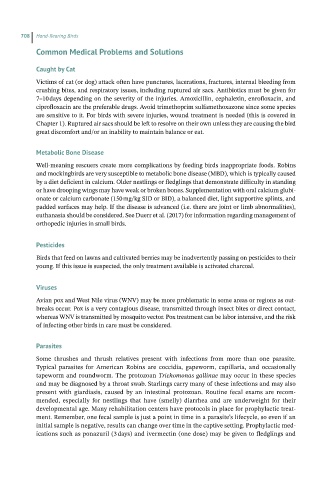Page 706 - Hand rearing birds second
P. 706
708 Hand-Rearing Birds
Common Medical Problems and Solutions
Caught by Cat
Victims of cat (or dog) attack often have punctures, lacerations, fractures, internal bleeding from
crushing bites, and respiratory issues, including ruptured air sacs. Antibiotics must be given for
7–10 days depending on the severity of the injuries. Amoxicillin, cephalexin, enrofloxacin, and
ciprofloxacin are the preferable drugs. Avoid trimethoprim sulfamethoxazone since some species
are sensitive to it. For birds with severe injuries, wound treatment is needed (this is covered in
Chapter 1). Ruptured air sacs should be left to resolve on their own unless they are causing the bird
great discomfort and/or an inability to maintain balance or eat.
Metabolic Bone Disease
Well‐meaning rescuers create more complications by feeding birds inappropriate foods. Robins
and mockingbirds are very susceptible to metabolic bone disease (MBD), which is typically caused
by a diet deficient in calcium. Older nestlings or fledglings that demonstrate difficulty in standing
or have drooping wings may have weak or broken bones. Supplementation with oral calcium glubi-
onate or calcium carbonate (150 mg/kg SID or BID), a balanced diet, light supportive splints, and
padded surfaces may help. If the disease is advanced (i.e. there are joint or limb abnormalities),
euthanasia should be considered. See Duerr et al. (2017) for information regarding management of
orthopedic injuries in small birds.
Pesticides
Birds that feed on lawns and cultivated berries may be inadvertently passing on pesticides to their
young. If this issue is suspected, the only treatment available is activated charcoal.
Viruses
Avian pox and West Nile virus (WNV) may be more problematic in some areas or regions as out-
breaks occur. Pox is a very contagious disease, transmitted through insect bites or direct contact,
whereas WNV is transmitted by mosquito vector. Pox treatment can be labor intensive, and the risk
of infecting other birds in care must be considered.
Parasites
Some thrushes and thrush relatives present with infections from more than one parasite.
Typical parasites for American Robins are coccidia, gapeworm, capillaria, and occasionally
tapeworm and roundworm. The protozoan Trichomonas gallinae may occur in these species
and may be diagnosed by a throat swab. Starlings carry many of these infections and may also
present with giardiasis, caused by an intestinal protozoan. Routine fecal exams are recom-
mended, especially for nestlings that have (smelly) diarrhea and are underweight for their
developmental age. Many rehabilitation centers have protocols in place for prophylactic treat -
ment. Remember, one fecal sample is just a point in time in a parasite’s lifecycle, so even if an
initial sample is negative, results can change over time in the captive setting. Prophylactic med-
ications such as ponazuril (3 days) and ivermectin (one dose) may be given to fledglings and

